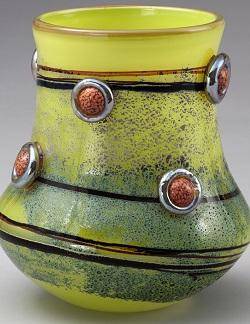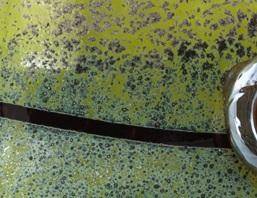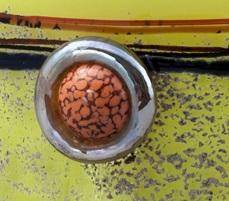Students will use innovation to create an object and develop the illusion that it is made from something not traditionally associated with the nature of the object.
Students will be able to:
- demonstrate an understanding of traditional influences in a work of art;
- make informed choices about media;
- use proper clay technique and craftsmanship;
- experiment to create faux textures; and
- create a work of art that articulates sophisticated ideas.
Lesson
Day 1
- Show students the image of Untitled (Kilt Series 06) by Tony Jojola. Ask them to describe what they see. What colors do they see? What materials do they think were used to make the object? Does the shape remind them of anything else they have studied? If so, what?
- Tell students that Jojola is from the Isleta Pueblo in New Mexico. He is from a family of potters and silversmiths, yet even as his cultural heritage is very important to him, he is drawn to a different medium—blown glass. He challenges the idea of “traditional” and reminds people that even though most think that silver is a traditional Native American medium, it wasn’t in the beginning. He says of his chosen medium, “to me, glass is like clay that you can’t touch.”
- Share with students information from the About the Art section. Point out that Jojola uses traditional beads and his grandfather’s silver stamps in many of his works. He also uses the traditional pottery shapes of his heritage, but in the surprising new medium of glass. He says that he “continue(s) to rely on (his) culture for inspiration, but (he) want(s) to be known as a contemporary artist, an innovator.”
- Tell students that using Jojola’s words as inspiration, they are going to be innovators as well. They will create a clay vessel and will alter the surface to make the object appear as though it is made from another material, such as a brown paper bag, a take-out coffee cup, wood, brick, concrete, woven fabric, or other materials. They can spend the rest of class brainstorming and making sketches.
Days 2:
- Tell students that, for this lesson, they will be learning how to work with clay, and experimenting with different techniques for creating textures.
- Start out by teaching them different hand building techniques and tips for forming shapes with clay. If you are familiar with how to work with clay, you can show them yourself. You can also use this video to learn these techniques, or show the video in class to teach the students. Give each student a handful of clay and any necessary tools so that they can follow along with you/the video. Tell them that they will be using the same ball of clay for learning different techniques, because this is just a practice day.
- Next, have students print out or locate images with the texture that they want to recreate.
- Have students return to their same handful of clay, and encourage them to experiment to get the right texture by incising the clay or pressing different tools or materials into it. If you think they need some inspiration or guidance, you can play the first part of this video to give them some ideas.
Day 3:
- On this day, students will be making their actual object. Give each student a block of clay to work with. Remind them of the tips and tricks learned in the last lesson, such as wedging their clay, making sure the walls of their piece are even, ensuring to attach different pieces of clay together properly, etc. Also encourage them to be gentle when adding texture to their pieces, and to use one hand to support the back side of any part of the clay that they are pressing into, so that their piece does not become deformed when they apply pressure to create a texture. They can use the whole class period for making their object.
Day 4:
- If students did not have time in the previous lesson, students can take some time on this day to paint their creations (have them use proper glazes if you are planning on firing the pieces).
- Hold a discussion on what students have learned throughout this project. You can facilitate this discussion by asking questions such as:
- What do you remember about Tony Jojola? Why do you think he used glass instead of clay to make his piece?
- Jojola’s work is very innovative. How were their own works innovative?
- Was it difficult making their clay pots look like something new? Would they do anything differently if they did the project again?
- To finish up the project, have each student informally present their piece by sharing with the class what texture they were going for, what techniques they used, etc.
*You can spread the lesson out over four days if you prefer, or combine various activities into single lessons if you want the lesson plan to be less spread out.
Materials
- Paper and pencils
- Drawing materials
- Clay and clay tools
- Images of a variety of textures, or student access to the internet and a printer so that they can find what they need
- A variety of fabrics, utensils, found objects (such as rocks or leaves), and any other items that students might want to use to create texture in their clay pieces (if need be, you can ask students to return on Day 2 or 3 with items they want to use)
- About the Art section on Untitled (Kilt Series 06) (included with the lesson plan) or student access to this part of Creativity Resource online
- Color copies of Untitled (Kilt Series 06), or the ability to project the image onto a wall or screen
- Optional: video on hand building techniques for clay, and access to a way to play it for the class
- Optional: video on adding texture to clay, and access to a way to play it for the class (you would only need to play the first part of this video, up to 1:57. If you want more ideas, there are many other videos on Youtube that you could use)
Standards
- Social Studies
- History
- Geography
- Analyze the concepts of continuity and change and effect
- Become familiar with people in the world who are interconnected by geography
- Visual Arts
- Invent and Discover to Create
- Observe and Learn to Comprehend
- Relate and Connect to Transfer
- Envision and Critique to Reflect
- Language Arts
- Research and Reasoning
- Collaboration
- Critical Thinking & Reasoning
- Information Literacy
- Invention
- Self-Direction
Untitled (Kilt Series 06)
- Tony Jojola, Isleta, American, 1958-2022
- Born: New Mexico
- Work Locations: Isleta pueblo
Tony Jojola (Ho-ho-la) is one of the most innovative glass artists in the United States. He was born in Isleta Pueblo in New Mexico in 1958 and grew up surrounded by artists. His grandfather and father were silversmiths and his grandmother was a potter. Jojola first learned glassblowing techniques at the Institute of American Indian Arts in Santa Fe, and then studied with internationally renowned glass artist Dale Chihuly at Pilchuck Glass School. After achieving career success, Jojola founded the Taos Glass Arts and Education program, which teaches young people how to express themselves in glass.
As more Pueblo artists learn to work in glass, the question of what is “traditional” comes up. Jojola looks at it this way: “Lots of people think silver is a traditional Native American medium, but it wasn’t in the beginning.”
Jojola’s family and cultural background have significantly influenced his work. He learned pottery making from his grandmother and continues to shape traditional forms, using glass instead of clay. “I feel that glass relates to clay very strongly,” he says. “To me, glass is like clay you can’t touch.” Jojola also honors his family by using his grandfather’s silver jewelry stamps on some of his glass vessels.
Jojola's time at the Pilchuck Glass School and exposure to artists like Vincent van Gogh also play a pivotal role in the work he creates. “I continue to rely on my culture for inspiration, but I want to be known as a contemporary artist, an innovator,” Jojola says.
Details

Shape
The shape of Untitled (Kilt Series 06) is reminiscent of the form of traditional Isleta Pueblo jars, such as the one shown in this image here.

Color
Jojola is known for his use of bright, distinctive colors, like this lime green with accents of red and black. “I love color, I love Van Gogh, but those paintings are not what inspired me. The colors I love are the ones we have in the world of New Mexico,” he says.

Red and Black Lines
Working from drawings, Jojola applies colored threads of glass with a hot torch while an assistant holds the piece steady. Jojola employs several skilled assistants because the glassblowing process requires him to move quickly and leaves little room for error.

Sparkly Surface
Jojola rolls or dips the glass in silver dust to create a sparkly surface.

The Red Beads
Jojola used Hubbell beads, originally sold at the Hubbell Trading Post in the late 1880s and 1890s, to embellish this vessel. The owner and founder of the trading post most likely bought the beads from Czech beadmakers and resold them to American Indian artists. We can assume that Jojola bought or collected these beads to use in his art.
Funding for object education resources provided by a grant from the Morgridge Family Foundation. Additional funding provided by the William Randolph Hearst Endowment for Education Programs, and Xcel Energy Foundation. We thank our colleagues at the University of Denver Morgridge College of Education.
The images on this page are intended for classroom use only and may not be reproduced for other reasons without the permission of the Denver Art Museum. This object may not currently be on display at the museum.







